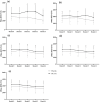The effect of acute branched-chain amino acids ingestion on rate of force development in different time intervals: a controlled crossover study
- PMID: 39845911
- PMCID: PMC11750653
- DOI: 10.3389/fnut.2024.1463202
The effect of acute branched-chain amino acids ingestion on rate of force development in different time intervals: a controlled crossover study
Abstract
Background: Branched-chain amino acids (BCAAs) are widely used as sports nutrition supplements. However, their impact on the rate of force development (RFD), an indicator of explosive muscle strength, has not yet been validated. This study aimed to assess the impact of BCAA supplementation on the RFD in college basketball players during simulated games.
Methods: This study employed a randomized, controlled crossover, double-blind design. Participants received either BCAAs (0.17 g/kg combined with 0.17 g/kg isocaloric glucose) or a placebo (0.34 g/kg isocaloric glucose) orally 30 min before beginning the exercise protocol. The RFD was quantified using the isometric mid-thigh pull (IMTP) test. Additional outcome measures, including strength and jump tests, agility and sprinting tests, and physiological responses, were also assessed. A two-way repeated measures ANOVA was employed to evaluate the impact of supplements (BCAAs and placebo) on RFD and other related outcome measures.
Results: Analysis of the 50 ms RFD demonstrated significant main effects of BCAA supplementation (p = 0.003). The BCAAs group consistently exhibited higher levels of 50 ms RFD compared to the placebo group across rounds 1 to 4. For example, in round 1, the 50 ms RFD was 3702.3 ± 1223.2 N/S in the BCAAs group versus 2931.3 ± 888.8 N/S in the placebo group (p = 0.045). Although no significant between-group differences were observed for the 100, 150, 200, and 250 ms RFD measurements, the BCAAs group consistently showed superior values across all time points. The results of other outcome indicators also suggested that supplementation with BCAAs was indeed effective.
Conclusion: The results indicate that BCAA supplementation can enhance RFD in basketball players, particularly at the 50 ms RFD. Our research design provides reliable insights into the effects of BCAAs on athletic performance. Further studies of similar design with larger sample sizes are necessary to confirm and extend these findings.
Clinical trial registration: Chinese Clinical Trial Registry, ChiCTR2400091314 (https://www.chictr.org.cn).
Keywords: BCAAs; branched-chain amino acids; controlled cross-over study; rate of force development; sports nutrition.
Copyright © 2025 Zhang, Li, Tu, Zhang, Shang, Liu and Li.
Conflict of interest statement
The authors declare that the research was conducted in the absence of any commercial or financial relationships that could be construed as a potential conflict of interest.
Figures


Similar articles
-
Isometric Midthigh Pull Performance Is Associated With Athletic Performance and Sprinting Kinetics in Division I Men and Women's Basketball Players.J Strength Cond Res. 2019 Oct;33(10):2665-2673. doi: 10.1519/JSC.0000000000002165. J Strength Cond Res. 2019. PMID: 28777249
-
Branched-Chain Amino Acids Supplementation Does Not Accelerate Recovery after a Change of Direction Sprinting Exercise Protocol.Nutrients. 2022 Oct 16;14(20):4331. doi: 10.3390/nu14204331. Nutrients. 2022. PMID: 36297014 Free PMC article. Clinical Trial.
-
The effects of acute branched-chain amino acid supplementation on recovery from a single bout of hypertrophy exercise in resistance-trained athletes.Appl Physiol Nutr Metab. 2017 Jun;42(6):630-636. doi: 10.1139/apnm-2016-0569. Epub 2017 Jan 27. Appl Physiol Nutr Metab. 2017. PMID: 28177706 Clinical Trial.
-
Branched chain amino acid therapy in liver disease.J Am Coll Nutr. 1985;4(6):639-50. doi: 10.1080/07315724.1985.10720106. J Am Coll Nutr. 1985. PMID: 3935706 Review.
-
Branched Chain Amino Acids (BCAAs) and Traumatic Brain Injury: A Systematic Review.J Head Trauma Rehabil. 2018 Jan/Feb;33(1):33-45. doi: 10.1097/HTR.0000000000000280. J Head Trauma Rehabil. 2018. PMID: 28060208
References
-
- Townsend JR, Bender D, Vantrease WC, Hudy J, Huet K, Williamson C, et al. . Isometric Midthigh pull performance is associated with athletic performance and sprinting kinetics in division I men and Women's basketball players. J Strength Cond Res. (2019) 33:2665–73. doi: 10.1519/JSC.0000000000002165, PMID: - DOI - PubMed
LinkOut - more resources
Full Text Sources
Miscellaneous

